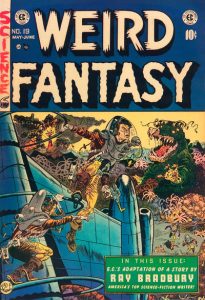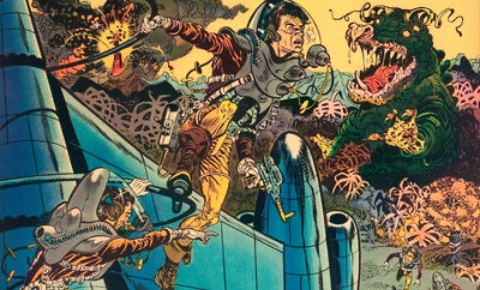
Bradbury and the Comics
Like movies, that “magician of words,” Ray Bradbury, was a graphic story enthusiast long before such people became commonplace. When he was nine years old, the future author spotted a brand new comic strip — BUCK ROGERS IN THE 25TH CENTURY — in his hometown newspaper, the WAUKEGAN NEWS. It was October 1929. The young Bradbury began to save every episode.
Two years later, the future writer discovered Hal Foster’s Sunday TARZAN strip. In early 1934, came Alex Raymond’s FLASH GORDON. Foster’s PRINCE VALIANT followed in 1937. He collected them all.
“Without all this splendid mediocrity, this sublime and wondrous trash in my background, I don’t think I would be any sort of writer today.”
According to Orty Ortwein, author of “Ray Bradbury: Comic Book Hero,” the comics helped to create the writer that Bradbury became. In return, the writer helped move the graphic storytelling medium forward.
In 1951, E.C. Comics began adapting Ray Bradbury’s fiction to the graphic format without payment or credit to the young author. In 2002, E.C. artist and editor Al Feldstein explained during a panel with Bradbury, Mark Evanier, and Julius Schwartz at Comic-Con International in San Diego, California:
“You have to understand how we worked, Bill Gaines and I. Bill Gaines was taking Dexedrine pills to lose weight, only he used to take them at night before dinner, so he was up all night wired. And he used to read, and he’d read things, and we used to have story ideas four times a week, and he brought in some story ideas, and I said those two combined would be great, and that’s the two stories into one that I wrote as an original story.”
Feldstein was referring to “Home to Stay,” a story featuring artwork by Wally Wood that was published in E.C. Comics’s WEIRD FANTASY #13, dated May-June 1952. The adaptation was drawn from “Kaleidoscope” and “Rocket Man,” two stories collected by Bradbury and published in THE ILLUSTRATED MAN (1951). Unbeknownst to the author at the time, E.C. had also adapted two stories from his book, DARK CARNIVAL (1947).
Rather than threatening the company with a lawsuit, Ray Bradbury wrote to E.C. publisher Bill Gaines:
“Just a note to remind you of an oversight. You have not as yet sent on the check for $50 to cover the use of secondary rights on my two stories ‘The Rocket Man’ and ‘Kaleidoscope.’ . . . I feel this was probably overlooked in the general confusion of the office work, and look forward to your payment in the near future.”
Now in his thirties and very much a fan of the graphic storytelling format, Bradbury was actually pleased to see what E.C. had done with his stories. He ended his letter with a suggestion . . .
“Have you ever considered doing an entire issue of your magazine based on my stories in DARK CARNIVAL, or my other two books, THE ILLUSTRATED MAN and THE MARTIAN CHRONICLES?”
Although Gaines did not take the author up on his idea for an all-Bradbury comic book, nor acknowledge his company’s trespass, he did pay Ray Bradbury the $50. He also arranged to adapt more stories, eventually publishing about thirty graphic adaptations based on Bradbury’s fiction.
Al Feldstein called the time when he was adapting Ray Bradbury’s stories to the comic book format, the most inspiring period of his life:
“To have the privilege to take this guy’s work, which was spectacular, and adapt it into the comic format, and try to be faithful to it, all of it, because every word is precious. It was a great pleasure and also a great tutorial for me as a writer. And I was really just a part-time writer. I wasn’t really a professional writer. I was an artist, and you’re an inspiration to me as an artist, because the way you wrote. You wrote like a painting. You took words that were colors and phrases that were brushstrokes, and you painted a visual picture that everyone in their own minds saw.”
In addition to some of the best illustrators in comic books — Jack Davis, Will Elder, Graham Ingels, Jack Kamen, Joe Orlando, Al Williamson, Wally Wood, and others — adapting his work, Bradbury was the only writer whose name was regularly displayed on E.C. covers. Although he received just $25 for each adaptation, the E.C. adaptations were introducing the author’s fiction to legions of young readers. Many surely went on to read the writer’s stories in the Bantam paperback editions of THE MARTIAN CHRONICLES, THE ILLUSTRATED MAN, and later books.
As his name grew in stature, Ray Bradbury asked E.C. Comics to remove his name from their comic book covers. However, he allowed them to adapt his work for as long as they desired. Unfortunately, as E.C. became the bane of those who claimed such books led to “juvenile delinquency and homosexuality,” the publisher ended its comic book line in early 1956.
 In 1993, writer, editor, and publisher Byron Preiss reprised the E.C. Comics/Ray Bradbury success story when he gathered together some of the best comic book illustrators of his day — Richard Corben, Dave Gibbons, Mike Mignola, P. Craig Russell, Daniel Torres, Tim Truman, Matt Wagner, and others — to adapt some of the author’s best-known works to the graphic story format. The result was a seven-book anthology series with the overarching title, THE RAY BRADBURY CHRONICLES. Over a dozen of these stories also appeared in a five-issue comic book series that was published by Topps Comics. Bradbury himself wrote introductions for all five issues of RAY BRADBURY COMICS.
In 1993, writer, editor, and publisher Byron Preiss reprised the E.C. Comics/Ray Bradbury success story when he gathered together some of the best comic book illustrators of his day — Richard Corben, Dave Gibbons, Mike Mignola, P. Craig Russell, Daniel Torres, Tim Truman, Matt Wagner, and others — to adapt some of the author’s best-known works to the graphic story format. The result was a seven-book anthology series with the overarching title, THE RAY BRADBURY CHRONICLES. Over a dozen of these stories also appeared in a five-issue comic book series that was published by Topps Comics. Bradbury himself wrote introductions for all five issues of RAY BRADBURY COMICS.
More recently, Hill & Wang published FAHRENHEIT 451, THE MARTIAN CHRONICLES, and SOMETHING WICKED THIS WAY COMES in the graphic novel format. Adapted by contemporary illustrators and released from 2009 to 2011, none received much acclaim.
Ninety years ago, Ray Bradbury’s classmates mocked him for collecting BUCK ROGERS. They taunted, “There aren’t going to be any rocket ships. We aren’t ever going to land on Mars or the moon.”
Initially, his peers convinced him. He tore apart his scrapbooks and tossed his collection into the trash. “It was all kids’ stuff, the ray guns and the rocket ships.“ But it was also Ray Bradbury’s head, heart, and soul.
Today, the graphic story medium is a leading popular culture format across the globe. As Ray Bradbury wrote in his introduction to THE AUTUMN PEOPLE, a collection of E.C. comic book adaptations of his work that was published by Ballantine Books in 1965:
“. . . it appears we are vindicated. The Pop Art people come along, late in the day, to tell us about comic strips and characters. . . . Our answer is: we knew it all the time! Don’t tell us about what we have already loved and loved well!
Please join PulpFest 2020 on Friday, August 7, as we welcome Don Simpson to discuss graphic visions of Ray Bradbury’s work at the DoubleTree by Hilton Hotel Pittsburgh – Cranberry in Mars, Pennsylvania. It’s part of our celebration of the 100th anniversary of the birth of author Ray Douglas Bradbury.
(Ray Bradbury received the 2010 Icon Award from Comic-Con International, recognizing his efforts to create “greater awareness of and appreciation for comic books and related popular art forms.”
Pittsburgh’s Donald E. Simpson is the cartoonist/creator of the comic books MEGATON MAN, BORDER WORLDS, and BIZARRE HEROES. He’s also the creator of several international underground comix sensations, published under the pseudonym Anton Drek, and the author of the young adult maxi-series, MS. MEGATON MAN. Don has taught workshops in cartooning and figure drawing for a number of years, and earned a Ph.D. from the University of Pittsburgh in History of Art and Architecture in 2013. He regularly reviews fiction and nonfiction books for the PITTSBURGH POST-GAZETTE.
Orty Ortwein is a librarian in Zionsville, Indiana and a volunteer for the Ray Bradbury Experience Museum in Waukegan, Illinois. His article “Ray Bradbury: Comic Book Hero” ran in the August 22, 2019 THE SATURDAY EVENING POST and proved to be an invaluable reference for this article. We recommend Orty’s article to anyone interested in Ray Bradbury and/or the graphic medium of storytelling.
Of course, pictured above you’ll find Joe Orlando’s cover for WEIRD FANTASY #19 — dated May/June 1953 — and the fourth volume of THE RAY BRADBURY CHRONICLES, with front cover art by William Stout.
For a look at our entire programming schedule, please click the Programming button below the PulpFest banner on our home page.)







